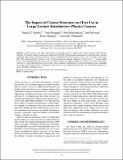The Impact of Course Structure on eText Use in Large-Lecture Introductory-Physics Courses
Author(s)
Seaton, Daniel T.; Bergner, Yoav; Kortemeyer, Gerd; Rayyan, Saif; Chuang, Isaac L.; Pritchard, David E.; ... Show more Show less
DownloadPublished version (1.459Mb)
Terms of use
Metadata
Show full item recordAbstract
Course structure - the types and frequency of learning activities - impacts how students interact with electronic textbooks. We analyze student-tracking logs generated by the LON-CAPA learning management system from nearly a decade of blended large-lecture introductory-physics courses at Michigan State University, as well as one on-campus course from MIT. Data mining provides estimates of the overall amount and temporal regularity of eText use, i.e., weekly reading versus review immediately before exams. For all courses studied, we compare student use of eTexts as it varies with course structure, e.g., from traditional (three or four exams, eText assigned as supplementary) to reformed (frequent exams, embedded assessment in the assigned eText). Traditional format courses are accompanied by little eText use, while high reading levels persist throughout reformed courses. Keywords: Introductory Physics; Course Structure; eText; Textbook; Blended
Date issued
2014-02Department
Massachusetts Institute of Technology. Office of Digital Learning; Massachusetts Institute of Technology. Department of Physics; Massachusetts Institute of Technology. Department of Electrical Engineering and Computer ScienceJournal
2013 PERC Proceedings
Publisher
American Association of Physics Teachers
Citation
Seaton, Daniel T., et al. "The Impact of Course Structure on eText Use in Large-Lecture Introductory-Physics Courses." Physics Education Research Conference, July 2013, Portland, OR, USA, edited by Paula V. Engelhardt, Alice Churukian, and Dyan L. Jones, American Association of Physics Teachers, 2014.
Version: Final published version
ISSN
1539-9028
2377-2379